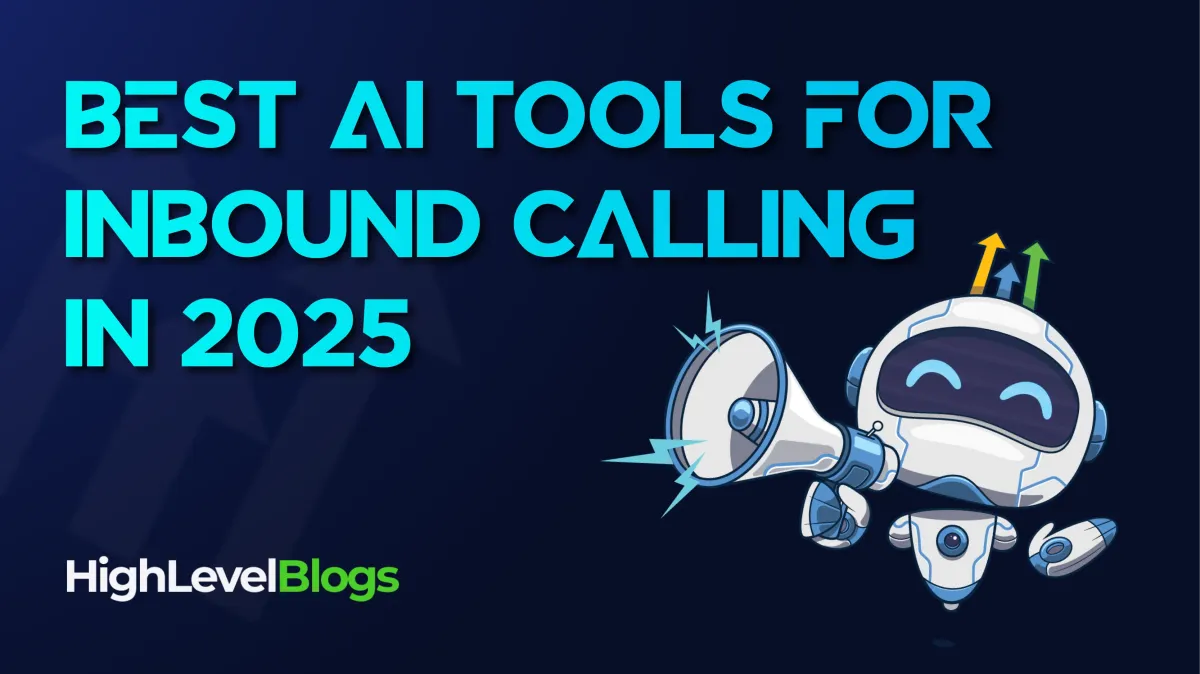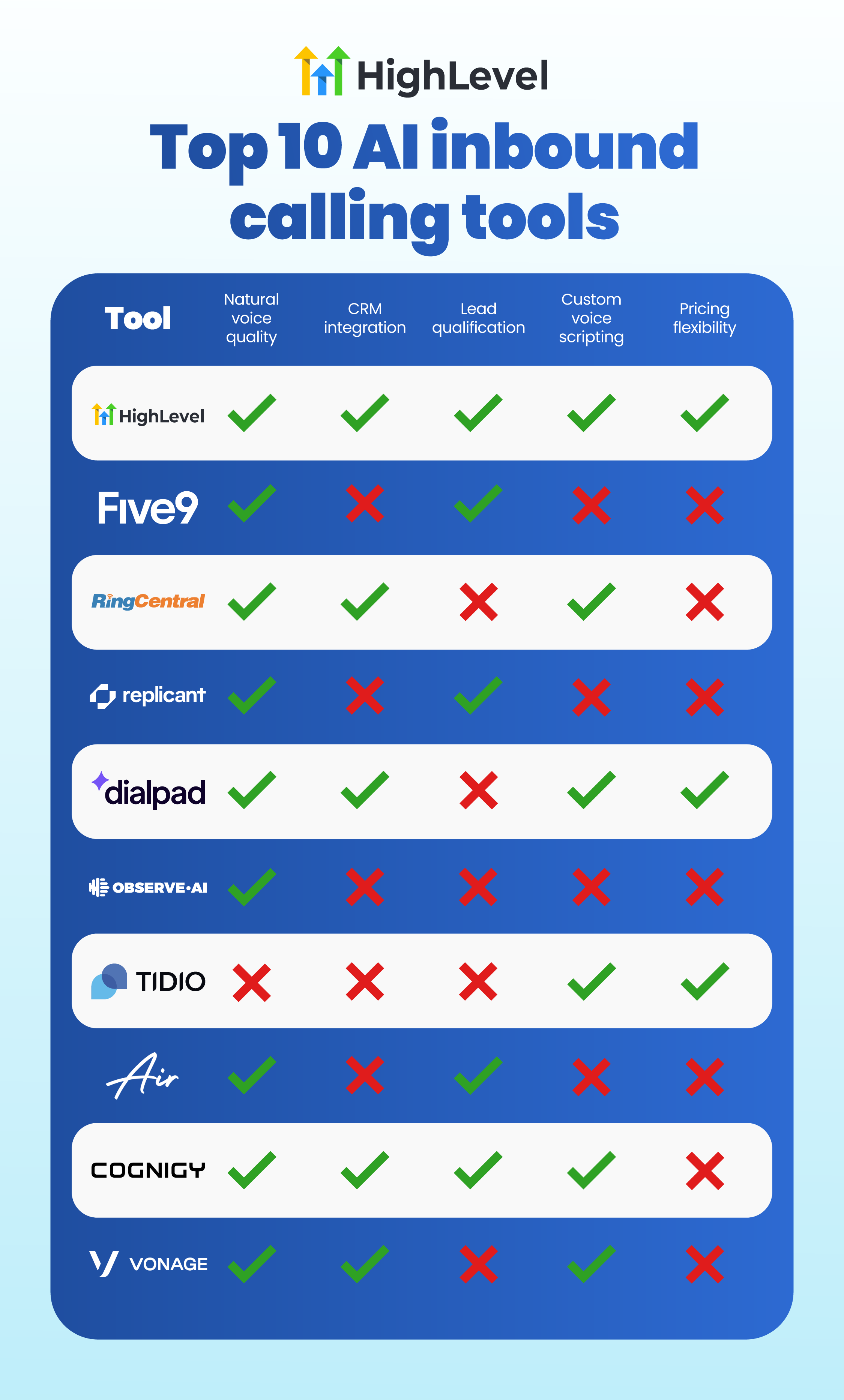
Best AI tools for inbound calling in 2025: Top 10 picks for agencies & SMBs
It starts with a ring.
One call can connect you with a new customer, or lose one before they even speak to a human. For agencies and small businesses, that first touchpoint often determines whether a lead turns into revenue.
But many teams still struggle to answer consistently. Calls go to voicemail after hours. Staff miss them while juggling other tasks. And potential customers move on.
That’s where AI-powered call handling comes in.
According to a study, 97% of businesses plan to use AI in customer communication in 2025, and 63% are investing in AI voice assistants specifically.
These tools are helping businesses stay responsive, capture more leads and handle higher volumes without hiring more people.
Adoption is climbing fast. But results still depend on the tool you choose.
So we’ve done the research for you. This guide covers 10 of the best AI inbound calling tools in 2025, what they do well, where they shine, and which one might actually save you time, money and missed opportunities.
Let’s jump in.
Why AI is reshaping inbound call handling for businesses
Most small business owners don’t want to become contact center managers. They just want the phone answered, the lead captured, the question resolved or the appointment booked.
But hiring 24/7 staff isn’t feasible. That’s where AI inbound calling tools come in.
A good AI phone agent doesn’t just pick up. It understands intent, responds in a natural voice, books meetings, qualifies leads, escalates smartly and follows up with summaries, all without human intervention.
And for agencies, white-labeling a smart inbound call system opens up a whole new revenue stream.
What to look for in a smart inbound calling tool in 2025
Before you compare platforms, get clear on what matters most for your business model.
Here are 5 features that separate the leaders from the laggards:
Natural voice quality: Does it sound human, or like a robot reading a script?
CRM + automation integration: Can it trigger workflows, update pipelines or log calls automatically?
Lead qualification: Can it route high-value leads or gather pre-sale info?
Customization: Can you train it with your own language, services and FAQs?
Scalability: Can it handle multiple calls at once? Can it grow with your team?
Let’s put those features to the test.

Top 10 AI inbound calling tools (in-depth company profiles)
1. HighLevel AI Voice
HighLevel developed its AI Voice agent as part of its all-in-one CRM and marketing stack. Designed from the ground up for agencies and SMBs, it syncs calling, workflows and automation seamlessly.
Agencies love the ease of white labeling voice agents. SMBs benefit from a unified login that consolidates calls, chat, bookings and CRM without juggling dozens of tools.
Standout features of HighLevel Voice AI
Natural, customizable voice agents with instant lead capture.
Real-time CRM logging and automated workflows.
True scalability: unlimited concurrent inbound calls.
Built-in AI summaries, handoffs and post-call triggers.
2. Five9 IVA
Five9 is a well-established contact center vendor. Its Intelligent Virtual Agent (IVA) is tailored for large-scale customer support operations, especially in regulated industries.
Organizations running full contact centers use Five9 for multilingual voice bots, routing and compliance-focused automation.
Pros
Reliable at scale.
Strong quality and compliance features.
Cons
Expensive for SMBs.
Difficult to customize outside enterprise teams.
3. RingCentral Engage Voice
RingCentral is famous for cloud-based phone systems. Engage Voice adds AI features into that ecosystem, improving basic call automation and transcription.
Teams using RingCentral for business phones can enable AI functions without adopting a separate voice interface.
Pros
Smooth adoption for existing RingCentral users.
eDiscovery and logging baked in.
Cons
Lacks lead qualification automation.
Voice is still largely rule-based.
4. Replicant
Founded to mimic human conversation at volume, Replicant operates in mission-critical call flows, think scheduling, FAQs and high-turnover inquiries.
Contact centers and global enterprises choose it for its uncanny accuracy in multi-turn conversations and prebuilt industry templates.
Pros
Deep understanding of caller intent.
Great for scripted, complex FAQ flows.
Cons
Setup cost and complexity.
Limited personalization scope for smaller brands.
5. Dialpad Ai Voice
Dialpad is a unified communications platform that has layered AI onto its calling features, offering agents insights during and after calls.
Pros
Affordable base-tier AI.
Easy to implement in existing systems.
Cons
Doesn’t qualify leads or trigger workflows.
AI assistance is reactive, not proactive.
6. Observe.AI
Observe.AI specializes in optimizing live agents.
Rather than replacing staff, it scores calls, highlights coaching opportunities and improves agent performance.
Pros
Powerful analytics on agent performance.
Ideal for heavily regulated environments.
Cons
Not a voice answering agent.
No automation or inbound handling.
7. Tidio AI Phone
Tidio began as a chatbot tool and extended into voice answering. It’s aimed at users who want basic call responses without human staffing.
Pros
Excellent low-cost introductory tool.
Easy setup without technical skill.
Cons
Robotic voice and limited capabilities.
No CRM connectivity or logic flows.
8. Air AI
Air AI positions itself as a smart AI sales rep. It can take inbound calls, qualify leads and engage in meaningful discovery.
Pros
Human-like discovery voice.
Great for outbound-first teams.
Cons
Limited CRM and calendar connections.
Not built for automation or after-hours handling.
9. Cognigy Voice Gateway
Tech-forward teams love Cognigy for its flexibility. It sits at the complex enterprise edge, delivering voice interactions across legacy systems and modern platforms.
Enterprises with diverse systems and API needs often use Cognigy to unify voice flows across channels and data systems.
Pros
Truly customizable platform.
Enterprise deployment ready.
Cons
Requires dev team to implement.
Too complex for lean SMBs.
10. Vonage AI Studio
Vonage extends its VOIP services with AI Studio’s visual workflow builder to automate voice and SMS interactions.
Pros
Intuitive builder UI.
Multi-channel trigger options.
Cons
AI remains basic and scripted.
Lacks CRM and workflow integration.
How HighLevel’s AI voice agent stands out with platform-level integration
While most platforms offer narrow functionality, HighLevel combines calling, CRM, automations, follow-ups and reports into a single login. That means fewer zaps, less breakage and faster ROI.
You can:
Train your agent on business-specific FAQs.
Set triggers that move leads through the pipeline.
Automatically notify your team of hot leads.
Trigger review requests after calls.
Hand off seamlessly to human agents when needed.
Conclusion: choose AI that connects, qualifies and converts
Inbound calls should be a revenue channel, not a black hole. With the right AI voice tool, you unlock a system that qualifies leads, books appointments, creates records and follows up instantly.
That’s the power of AI when it works with your stack, not next to it.
Jump into HighLevel’s Summer of AI
HighLevel’s Summer of AI promo gives you 30 days of unlimited AI tools, including Voice AI, Review AI, Content AI, Funnel Builder AI, AI Workflow Assistant and more.
Here’s what you get:
Full access to every AI Employee feature.
A kickoff call to map it all to your use cases.
Built-in tools to launch faster than ever.
The AI agent your clients are waiting for is already here. Now’s your chance to launch it.

